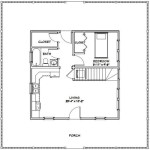A House Flipping Business Plan is a detailed roadmap for purchasing, renovating, and selling a residential property for profit. It outlines the steps, strategies, and financial projections involved in the house flipping process.
To illustrate, a real estate investor named John identifies a rundown house for $50,000. By carefully planning renovations that enhance the property’s value, such as kitchen and bathroom upgrades, he estimates he can sell the house for $80,000 after expenses. By following a comprehensive House Flipping Business Plan, John can minimize risks and increase his chances of achieving his profit margin.
In this article, we will delve into the key elements of a House Flipping Business Plan, providing insights and guidance for navigating the complexities of this lucrative investment strategy.
A comprehensive House Flipping Business Plan should encompass the following key elements:
- Market Analysis
- Property Selection
- Renovation Plan
- Budget and Financing
- Timeline and Exit Strategy
- Risk Assessment
- Project Management
- Legal Considerations
By addressing these essential points, house flippers can establish a solid foundation for success and navigate the potential pitfalls associated with this investment strategy.
Market Analysis
Conducting a thorough market analysis is crucial for the success of any house flipping venture. This involves gathering and examining data to understand the local real estate market, identify potential investment opportunities, and assess the viability of your flipping project.
Begin by researching the specific neighborhood where you plan to flip houses. Analyze recent sales data to determine the average home prices, appreciation rates, and days on market. This will provide insights into the overall health of the neighborhood and the potential return on investment for your project.
Next, identify the target market for your flipped homes. Consider the demographics of the area, including age, income levels, and family size. This will help you determine the types of renovations and upgrades that will appeal to potential buyers and maximize your profit margin.
Finally, track market trends and economic indicators that may impact the real estate market. Monitor interest rates, inflation, and job growth, as these factors can influence buyer demand and property values. By staying informed about market conditions, you can make informed decisions throughout the flipping process.
A comprehensive market analysis will provide you with a clear understanding of the local real estate market and help you make strategic decisions that increase your chances of success in house flipping.
Property Selection
Selecting the right property is crucial for the success of any house flipping project. This involves identifying properties that have the potential to generate a profit after renovation and resale.
Begin by identifying neighborhoods with strong potential for appreciation and high demand. Research local market trends, school districts, and amenities to determine which areas are likely to attract buyers. Consider the target market for your flipped homes and choose properties that align with their needs and preferences.
Next, look for properties that are priced below market value. This may include homes that are in need of or have been on the market for an extended period. Analyze the property’s condition carefully to determine the scope and cost of necessary renovations. Factor in the potential resale value after renovations to ensure that the project is financially viable.
Evaluate the property’s layout and features to ensure that it has the potential to meet the needs of potential buyers. Consider the number of bedrooms and bathrooms, the size and functionality of the kitchen and living areas, and the presence of desirable amenities such as a yard, garage, or finished basement.
Finally, conduct a thorough inspection of the property to identify any major issues or repairs that may impact the project’s timeline or budget. Hire a professional inspector to provide an objective assessment of the property’s condition and identify any potential problems that may affect its value.
By following these steps, you can increase your chances of selecting a property that has the potential to generate a profit and contribute to the success of your house flipping business.
Renovation Plan
The renovation plan is a crucial component of any house flipping business plan. It outlines the specific improvements and upgrades that will be made to the property to enhance its value and appeal to potential buyers.
Begin by identifying the areas of the property that have the greatest potential for improvement. This may include the kitchen, bathrooms, flooring, or curb appeal. Consider the target market for your flipped homes and prioritize renovations that will appeal to their needs and preferences.
Next, create a detailed budget for the renovations, including materials, labor, and permits. It is important to be realistic about the costs involved and to factor in a contingency fund for unexpected expenses. Consider hiring a contractor to provide a professional estimate and ensure that the project is completed to a high standard.
Develop a timeline for the renovations, taking into account the scope of the work, the availability of contractors, and the desired completion date. It is important to set realistic timelines and to communicate them clearly to all parties involved in the project.
Finally, select materials and finishes that are both durable and aesthetically pleasing. Consider the overall design of the property and choose materials that complement the existing architecture and style. By following these steps, you can create a comprehensive renovation plan that will maximize the value of your flipped home and increase your chances of a successful sale.
Budget and Financing
Creating a detailed budget is essential for the success of any house flipping project. This involves estimating the total cost of the project, including the purchase price of the property, renovation expenses, holding costs, and closing costs.
Begin by gathering quotes from contractors for all necessary renovations. Factor in the cost of materials, labor, and permits. Be sure to include a contingency fund for unexpected expenses, which can range from 10% to 20% of the total renovation budget.
Next, determine the holding costs associated with the property. These costs include property taxes, insurance, utilities, and maintenance. Estimate the length of time the property will be on the market and factor these costs into your budget.
Finally, calculate the closing costs, which typically include loan origination fees, title insurance, and attorney fees. These costs can vary depending on the location of the property and the type of financing used.
Once you have a clear understanding of the total project costs, you can begin to explore financing options. This may include traditional bank loans, hard money loans, or private financing. Each type of financing has its own advantages and disadvantages, so it is important to carefully consider your options and choose the one that best suits your needs.
By creating a detailed budget and securing appropriate financing, you can ensure that your house flipping project is financially feasible and has the potential to generate a profit.
Timeline and Exit Strategy
Establishing a realistic timeline and a clear exit strategy is crucial for the success of any house flipping project. This involves setting target completion dates for renovations, marketing the property effectively, and determining the optimal time to sell for maximum profit.
- Set Target Completion Dates:
Create a detailed timeline for the renovation process, taking into account the scope of work, the availability of contractors, and the desired completion date. Communicate these deadlines clearly to all parties involved in the project to ensure that the property is ready for sale on schedule.
- Market the Property Effectively:
Develop a comprehensive marketing plan to showcase the property’s best features and reach potential buyers. This may include listing the property on multiple platforms, hosting open houses, and utilizing social media to generate interest. Consider hiring a professional photographer to capture high-quality images that highlight the property’s renovations and appeal.
- Determine the Optimal Time to Sell:
Monitor market conditions and track comparable sales in the area to determine the optimal time to list the property for sale. Consider seasonal trends, economic indicators, and the availability of competing properties to maximize your chances of selling the home quickly and for a profit.
- Negotiate and Close the Sale:
Once you have received offers on the property, carefully review the terms and negotiate to achieve the best possible price and closing date. Work with a real estate agent to ensure that all legal documents are properly executed and that the sale proceeds smoothly.
By adhering to a well-defined timeline and implementing an effective exit strategy, you can increase your chances of completing your house flipping project on time, maximizing your profit, and successfully transitioning to the next investment opportunity.
Risk Assessment
A comprehensive risk assessment is crucial for mitigating potential pitfalls and ensuring the success of any house flipping project. This involves identifying and analyzing potential risks, developing strategies to minimize their impact, and implementing contingency plans to address unforeseen challenges.
- Market Downturn:
The real estate market can be cyclical, and downturns can significantly impact property values. To mitigate this risk, thoroughly research market trends, analyze economic indicators, and consider investing in areas with strong fundamentals and a history of stability.
- Construction Delays and Cost Overruns:
Unforeseen delays and cost overruns during renovations can eat into profits and impact project timelines. To minimize this risk, create a detailed renovation plan, secure reliable contractors, and establish a realistic budget with a contingency fund to cover unexpected expenses.
- Hidden Property Defects:
Hidden structural or mechanical issues can surface during renovations or after the property is sold, leading to costly repairs or legal disputes. To mitigate this risk, conduct thorough property inspections, hire qualified contractors, and obtain appropriate insurance coverage to protect against potential liabilities.
- Difficulty Selling:
Even in favorable market conditions, selling a flipped property can take time and effort. To minimize this risk, price the property competitively, market it effectively, and be prepared to negotiate with potential buyers while still maintaining a profit margin.
By conducting a thorough risk assessment and implementing appropriate mitigation strategies, house flippers can increase their chances of success and minimize the potential impact of unforeseen challenges.
Project Management
Effective project management is crucial for the success of any house flipping project. It involves planning, organizing, and controlling resources to complete the project within the established timeline and budget.
- Establish Clear Goals and Objectives:
Define the specific goals and objectives of the project, including the desired profit margin, renovation timeline, and target completion date. Communicate these goals clearly to all stakeholders involved in the project.
- Create a Detailed Work Plan:
Develop a comprehensive work plan that outlines the specific tasks, responsibilities, and timelines for each phase of the project. This plan should include milestones, dependencies, and contingencies to ensure that the project stays on track.
- Manage Resources Effectively:
Identify and secure the necessary resources, including contractors, materials, and equipment, to complete the project. Monitor resource allocation and adjust as needed to ensure that the project is completed efficiently and within budget.
- Control Costs and Timeline:
Track project expenses and compare them to the established budget regularly. Implement cost-control measures and make adjustments as necessary to stay within the financial constraints. Monitor progress against the timeline and identify potential delays or roadblocks to ensure that the project is completed on schedule.
By implementing effective project management practices, house flippers can increase their chances of completing their projects successfully, on time, and within budget.
Legal Considerations
Understanding and complying with legal considerations is paramount for the success of any house flipping business. Navigating the legal landscape can help house flippers mitigate risks, protect their interests, and ensure that their projects are conducted ethically and within the boundaries of the law.
- Property Ownership and Title:
Conduct thorough title searches to verify the ownership of the property and identify any liens or encumbrances that may affect its value or marketability. Ensure that you have a clear title to the property before proceeding with renovations or sale.
- Building Permits and Inspections:
Obtain all necessary building permits and have the property inspected by qualified professionals to ensure that the renovations comply with local building codes and safety regulations. Failure to do so may result in legal penalties, delays, and potential safety hazards.
- Contractor Agreements:
Enter into written contracts with contractors that clearly outline the scope of work, payment terms, timelines, and dispute resolution mechanisms. These contracts should protect both parties and ensure that the project is completed according to agreed-upon specifications.
- Disclosure Requirements:
Fully disclose any material defects or known issues with the property to potential buyers. Failure to disclose such information can lead to legal liability and damage the reputation of your business. It is crucial to be transparent and honest in all dealings to build trust and maintain a positive reputation in the industry.
By adhering to these legal considerations and seeking professional advice when necessary, house flippers can minimize risks, protect their interests, and conduct their business with integrity and professionalism.










Related Posts








